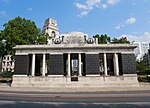The Tower Hill Memorial is a pair of Commonwealth War Graves Commission memorials in Trinity Square Gardens, on Tower Hill in London, England. The memorials, one for the First World War and one for the Second, commemorate civilian merchant sailors and fishermen who were killed as a result of enemy action and have no known grave. The first, the Mercantile Marine War Memorial, was designed by Sir Edwin Lutyens and unveiled in 1928; the second, the Merchant Seamen's Memorial, was designed by Sir Edward Maufe and unveiled in 1955. A third memorial, commemorating merchant sailors who were killed in the 1982 Falklands War, was added to the site in 2005.
The first memorial was commissioned in light of the heavy losses sustained by merchant shipping in the First World War—more than 17,000 lives were lost and some 3,300 British and Empire-registered commercial vessels sunk as a result of enemy action. The Imperial War Graves Commission (IWGC) commissioned Lutyens, who initially designed a massive arch on the banks of the River Thames, but this was rejected by the authorities, to Lutyens' disdain. A compromise was struck, as a result of which the memorial was constructed in Trinity Square Gardens on Tower Hill, a site further from the river but with a long maritime history. The site was crown land, meaning a special Act of Parliament was required to allow the construction. Queen Mary unveiled the memorial on 12 December 1928 at a ceremony broadcast live on the radio, her first use of the medium. The memorial is a vaulted corridor reminiscent of a Doric temple and similar to Lutyens' structures in cemeteries on the Western Front. The walls are clad with bronze panels which bear the names of the missing.
Merchant shipping losses in the Second World War were significantly higher than in the first (4,786 ships, 32,000 lives) and the IWGC commissioned a second memorial on the same site, intended to complement the first. Maufe designed a sunken garden, accessed by steps behind the original memorial, the walls of which were again clad with bronze panels with the names of the missing. At regular intervals between the panels are relief sculptures (by Charles Wheeler) representing the seven seas. Wheeler also sculpted two sentries, a Merchant Navy sailor and officer, which stand at the top of the steps. The new memorial was unveiled by Queen Elizabeth II in November 1955, after which relatives of those named on it were invited to lay flowers.
The memorials to the world wars are both listed buildings—the Mercantile Marine Memorial is grade I and part of a national collection of Lutyens' war memorials, and Maufe's Merchant Seamen's Memorial is listed at grade II*. The Falklands War memorial is not listed.












